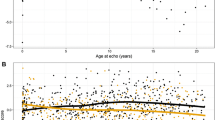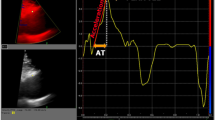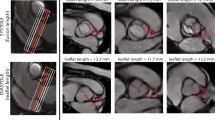Abstract
Aortic root size and cusp fusion pattern have been related to disease outcomes in bicuspid aortic valve (BAV). This study seeks to characterize symmetry of the aortic sinuses in adult and pediatric BAV patients and its relationship to valvulopathy and root aortopathy. Aortic sinus-to-commissure (S-C) lengths were measured on cardiac MRI of adult and pediatric BAV patients with right-and-left coronary (RL) or right-and-non-coronary (RN) leaflet fusion and tricuspid aortic valve (TAV) controls. Coefficient of variance (CoV) of S-C lengths was calculated to quantify sinus asymmetry, or eccentricity. BAV cohort included 149 adults (48 ± 15 years) and 51 children (15 ± 5 years). TAV cohort included 40 adults (60 ± 13 years) and 20 children (15 ± 5 years). In adult and pediatric BAV patients, the non-fused aortic sinus was larger than either fused sinus. In RL fusion, the non-coronary S-C distance was larger than right or left S-C distances in adults (n = 121, p < 0.001) and larger than the right S-C distance in children (n = 41, p = 0.013). Sinus eccentricity (CoV) in BAV patients was higher than in TAV patients (p < 0.001) and did not correlate with age (p = 0.12). CoV trended higher in RL adults with aortic regurgitation (AR) compared to those without AR (p = 0.081), but was lower in RN adults with AR than without AR (p = 0.006). CoV did not correlate to root Z scores (p = 0.06–0.55) or ascending aortic (AAo) Z scores in adults (p = 0.45–0.55) but correlated negatively to AAo Z score in children (p = 0.005–0.03). Most adult and pediatric BAV patients with RL and RN leaflet fusion demonstrate eccentric dominance of the non-fused aortic sinus irrespective of age. The degree of eccentricity varies with valve dysfunction and BAV phenotype but does not relate to the degree of aortic root dilatation, nor does eccentricity correlate with ascending aorta dilatation in adults.







Similar content being viewed by others
References
Basso C, Boschello M, Perrone C et al (2004) An echocardiographic survey of primary school children for bicuspid aortic valve. Am J Cardiol 93:661–663
Roberts WC (1970) The congenitally bicuspid aortic valve. A study of 85 autopsy cases. Am J Cardiol 26:72–83
Michelena HI, Khanna AD, Mahoney D et al (2011) Incidence of aortic complications in patients with bicuspid aortic valves. JAMA 306:1104–1112
Kang JW, Song HG, Yang DH et al (2013) Association between bicuspid aortic valve phenotype and patterns of valvular dysfunction and bicuspid aortopathy: comprehensive evaluation using MDCT and echocardiography. JACC Cardiovasc Imaging 6:150–161
Kong WK, Delgado V, Poh KK et al (2017) Prognostic implications of raphe in bicuspid aortic valve anatomy. JAMA Cardiol 2:285–292
Barker AJ, Markl M, Burk J et al (2012) Bicuspid aortic valve is associated with altered wall shear stress in the ascending aorta. Circ Cardiovasc Imaging 5:457–466
Mahadevia R, Barker AJ, Schnell S et al (2014) Bicuspid aortic cusp fusion morphology alters aortic three-dimensional outflow patterns, wall shear stress, and expression of aortopathy. Circulation 129:673–682
Capoulade R, Teoh JG, Bartko PE et al (2018) Relationship between proximal aorta morphology and progression rate of aortic stenosis. J Am Soc Echocardiogr 31:561–569.e561
Michelena HI, Della Corte A, Prakash SK et al (2015) Bicuspid aortic valve aortopathy in adults: incidence, etiology, and clinical significance. Int J Cardiol 201:400–407
Detaint D, Michelena HI, Nkomo VT et al (2014) Aortic dilatation patterns and rates in adults with bicuspid aortic valves: a comparative study with Marfan syndrome and degenerative aortopathy. Heart (British Cardiac Society) 100:126–134
Torres FS, Windram JD, Bradley TJ et al (2013) Impact of asymmetry on measurements of the aortic root using cardiovascular magnetic resonance imaging in patients with a bicuspid aortic valve. Int J Cardiovasc Imaging 29:1769–1777
Vis JC, Rodriguez-Palomares JF, Teixido-Tura G et al (2019) Implications of asymmetry and valvular morphotype on echocardiographic measurements of the aortic root in bicuspid aortic valve. J Am Soc Echocardiogr 32:105–112
Chubb H, Simpson JM (2012) The use of Z-scores in paediatric cardiology. Ann Pediatr Cardiol 5:179–184
Campens L, Demulier L, De Groote K et al (2014) Reference values for echocardiographic assessment of the diameter of the aortic root and ascending aorta spanning all age categories. Am J Cardiol 114:914–920
Michelena HI, Prakash SK, Della Corte A et al (2014) Bicuspid aortic valve: identifying knowledge gaps and rising to the challenge from the International Bicuspid Aortic Valve Consortium (BAVCon). Circulation 129:2691–2704
Entezari P, Schnell S, Mahadevia R et al (2014) From unicuspid to quadricuspid: influence of aortic valve morphology on aortic three-dimensional hemodynamics. J Magn Reson Imaging 40:1342–1346
Vis JC, Rodriguez-Palomares JF, Teixido-Tura G et al (2018) Implications of asymmetry and valvular morphotype on echocardiographic measurements of the aortic root in bicuspid aortic valve. J Am Soc Echocardiogr 32:105–112
Fernandez B, Duran AC, Fernandez-Gallego T et al (2009) Bicuspid aortic valves with different spatial orientations of the leaflets are distinct etiological entities. J Am Coll Cardiol 54:2312–2318
Phillips HM, Mahendran P, Singh E et al (2013) Neural crest cells are required for correct positioning of the developing outflow cushions and pattern the arterial valve leaflets. Cardiovasc Res 99:452–460
Beroukhim RS, Kruzick TL, Taylor AL et al (2006) Progression of aortic dilation in children with a functionally normal bicuspid aortic valve. Am J Cardiol 98:828–830
Spaziani G, Ballo P, Favilli S et al (2014) Clinical outcome, valve dysfunction, and progressive aortic dilation in a pediatric population with isolated bicuspid aortic valve. Pediatr Cardiol 35:803–809
Merkx R, Duijnhouwer AL, Vink E et al (2017) Aortic diameter growth in children with a bicuspid aortic valve. Am J Cardiol 120:131–136
Hope MD, Hope TA, Meadows AK et al (2010) Bicuspid aortic valve: four-dimensional MR evaluation of ascending aortic systolic flow patterns. Radiology 255:53–61
Rodriguez-Palomares JF, Dux-Santoy L, Guala A et al (2018) Aortic flow patterns and wall shear stress maps by 4D-flow cardiovascular magnetic resonance in the assessment of aortic dilatation in bicuspid aortic valve disease. J Cardiovasc Magn Reson 20:28
Aicher D, Kunihara T, Abou Issa O et al (2011) Valve configuration determines long-term results after repair of the bicuspid aortic valve. Circulation 123:178–185
Ugur M, Schaff HV, Suri RM et al (2014) Late outcome of noncoronary sinus replacement in patients with bicuspid aortic valves and aortopathy. Ann Thorac Surg 97:1242–1246
Funding
None.
Author information
Authors and Affiliations
Corresponding author
Ethics declarations
Conflict of interest
The authors of this manuscript declare no relevant conflicts of interest.
Additional information
Publisher's Note
Springer Nature remains neutral with regard to jurisdictional claims in published maps and institutional affiliations.
Rights and permissions
About this article
Cite this article
Stefek, H.A., Lin, K.H., Rigsby, C.K. et al. Eccentric Enlargement of the Aortic Sinuses in Pediatric and Adult Patients with Bicuspid Aortic Valves: A Cardiac MRI Study. Pediatr Cardiol 41, 350–360 (2020). https://doi.org/10.1007/s00246-019-02264-3
Received:
Accepted:
Published:
Issue Date:
DOI: https://doi.org/10.1007/s00246-019-02264-3




